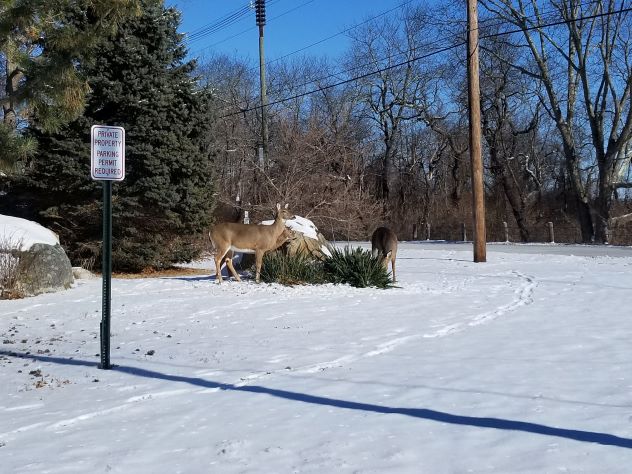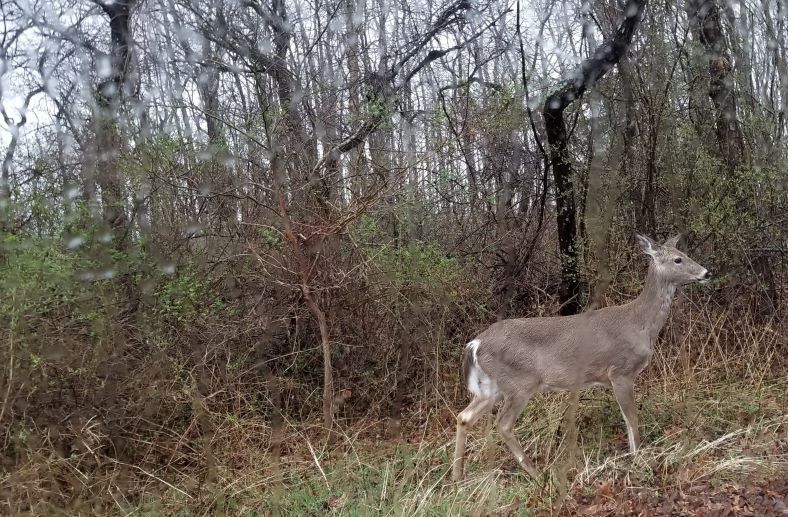Written by Charlotte Pyle
Chair, CIPWG Native Plant Alternatives Subcommittee
July 2023
A PRELIMINARY LIST OF DEER RESISTANT NATIVE PERENNIALS
First off, no plant is truly deer proof! Fawns will try anything once; and when there is nothing else to eat, all deer will eat plants they have never touched before. Note that in different places, deer will favor different plants, so what is billed as deer resistant may not be so on your site. Conversely, you may successfully grow a species that other people usually lose to deer. Also, deer may ignore a species one year and go after it the next.

Small, young plants are the most vulnerable. You will have better success if you plant larger individuals. If you are buying plants, you might want to re-pot them and let them get larger in a safe place before you plant them out.
Nurse plants can help. When planting new plants, intersperse them with a nurse plant species you have found to be highly deer resistant (often species such as mountain mints – Pycnanthemum spp., other mints, irises, ferns, sedges or grasses). After the nurse plants have done their job, you may wish to remove or thin them. If your site is informal, try “planting” some sturdy, branched twigs around and crossing over small plants.
Other barriers to deer browsing include chemical repellents and fences. People have good success with various deer repellents but note that they need to be reapplied (typically when when you are out of town or otherwise unavailable). And, of course, you can fence your entire garden area or put up temporary deer barriers in Winter.

All the plants on this list are native to Connecticut. In the eastern USA, there has been some confusion about what plants are native where. For Connecticut and the rest of New England, the best source is the maps shown for each species at https://GoBotany.NativePlantTrust.org/
Following the plant names (alphabetized by Common Name), the Notes tell a little bit about each plant: moisture and light requirements, size, flower color and other details of appearance, and where it might be used. Some of the plants are delicate and suited to a small wildflower garden. Others can be aggressive spreaders more suited to wildflower meadows or forests and will take active management to keep them in from being too aggressive in a small garden. https://GoBotany.NativePlantTrust.org/ is a source of plant photos (geared toward I.D., not garden beauty).
Blue Flag Iris, Iris versicolor – Wet or moist soils in Sun to Part-Shade. Will grow in water, at water’s edge, in wet meadows, or in the garden. Flowers large, showy, blue-violet to purple in late Spring. Long, arching wide, flat leaves.
Bluets, Houstonia caerulea – Wet to Dry soils in Sun to Light-Shade. Delicate plants with 4-petaled, pale blue flowers with yellow centers on thin stalks above a tiny cluster of leaves in Spring. 1″-4″ tall; clumps 3″ wide. Grow them where they will be free of competition. They do well on bare soil, moss and gravel (or thin spots in a lawn or dry meadow) and may find their way into your yard on their own. They die back after flowering, but later creeping roots form new plants.
Broad-leaved Mountain Mint, Pycnanthemum muticum – Moist soils in Sun to Part-Shade (few flowers if not in sun). Small white flowers clustered at the tips of tall, leafy flowering stems in mid-to late-Summer. (use magnifying glass to enjoy pink dots on petals) Beneath the flower clusters are silvery-colored leaf-sized bracts. Plants 3′-4′ tall; 2′-3′ wide. Leaves wilt in drought. Broad-leaved mountain mint spreads aggressively from underground stems — welcome in a wildflower meadow but will need to be aggressively cut back on all sides with a shovel each Spring to keep it from dominating a small garden. Excellent nectar source for butterflies and bees. Deer avoid this plant. If you control its root-spreading, it is a good species to use to camouflage plants less resistant to deer browse.
Canada Mayflower, Maianthemum canadense – Wet to Dry soils in Part-Sun to Deep Shade. Flowers white, delicate, in Spring. Height 2″ -4″; Good choice for dry, shaded woods. Spreads underground and can survive as a ground cover in the shade of taller plants. Can become a garden pest, but do not confuse with the taller, extremely aggressive, European Lily-of-the-Valley (Convallaria majalis) which has hanging, bell-shaped flowers and leaves longer than 4" with tapered or rounded, (not heart-shaped) leaf bases.
Doll’s Eyes, Actaea pachypoda – Moist soils in Part-Sun to Shade. Native to rich woods. Flowers white in Spring. Berries on thick purple stems, usually white with black dot (doll’s eye) at tip in Summer-Fall. Plants with coarsely lacy foliage, 20″-30″ tall, 12″-16″ wide. CAUTION: All plant parts are poisonous; fatal to humans, pets, and livestock if eaten in large quantities (especially berries and roots; but unlikely due to bad taste).
Golden Alexanders, Zizia aurea – Wet to Moist soils in Sun to Light-Shade. Cheerful yellow flower clusters in late-Spring on stalks above bright green leaves; flowers in umbels (like Dill); and like Dill is a host plant for Swallowtail butterfly caterpillars; attractive to insect pollinators including short-tongued bees, wasps, flies, and beetles. 1′-3′; tall; 12′-16″ wide Naturalizes well, can be weedy.
Jack-in-the-Pulpit, Arisaema triphyllum – Moist soils with abundant organic matter in Shade or Part-Shade. Plant with two large, three-parted leaves. The showy part of the flower is a leafy, cup-like structure with green or burgundy stripes (the pulpit) that houses a spike of inconspicuous flowers (the jack) in Spring that develop into a cluster of red berries in Fall. Height 12″-28″; width 12″-16″
Mayapple, Podophyllum peltatum – Moist to Dry soils in Part-Sun to Shade. Once established it becomes an aggressive tall, yellow-green, groundcover (needing control in a small garden). White flower and fruit hang beneath umbrella leaf. 8″- 16″ tall. Stays green till early fall or summer drought. CAUTION: Ripe fruits are edible, but green fruits and all other plant parts are poisonous.
Narrow-leaved Blue-eyed Grass, Sisyrinchium angustifolium – Moist soils in Sun to Part-Sun. Delicate plant with grass-like leaves. Flowers blue, 1/2″ wide, 6-parted, upward-facing with bright yellow centers in late-Spring to early-Summer. 10″-20″ tall; 6″-8″ wide. Plant groups of several individuals to be noticed from a distance. Will self-seed.
Narrow-leaved Mountain Mint, Pycnanthemum tenuifolium – Moist to Dry Soils in Sun to Part-Shade. Small white flowers clustered at the tips of leafy flowering stems in mid- to late-Summer. Leaves strikingly narrow. As with other Mountain Mints, the plants spread by rhizomes (underground stems). In Spring, use a shovel to cut back spreading rhizomes on all sides of a plant (or patch) to prevent excess spreading. Excellent nectar source for butterflies and bees. Deer avoid this plant. If you control its root-spreading, it is a good species to use to camouflage plants less resistant to deer browse.
Orange Butterfly Weed, Asclepias tuberosa – Well-drained, somewhat Dry to Dry soil in Sun to Part-Sun. A Monarch Butterfly host plant (Milkweed genus [Asclepias]). Leaves glossy green. Summer flowers in large, showy, flat-topped clusters, typically bright orange (also red-orange, pinkish, or yellow). Plant when small because after roots develop more it does not transplant well. In Fall, long cylindrical pods release fluffy, windborne seeds.
Partridgeberry, Mitchella repens – Moist to Dry soils in Part-Sun to Shade. Evergreen ground cover with rounded leaves and white mid vein. White flowers, Spring to Summer. Red berries last through Winter. 1″-2″ tall; 12″-16″ spread. For best growth, prevent smothering by tree leaves in Fall. Do not confuse with juvenile, non-native Winter- creeper (Euonymus fortunei) which acts invasively and has similar leaves except for pointed tips and easily seen teeth and upward-growing tendency (ultimately to become a woody, tree-strangling, aerial vine with aerial roots and elliptically shaped mature leaves of a dark-green or variegated (cultivars) color).
Pennsylvania Sedge, Carex pensylvanica – Moist to Moderately Dry acidic soils in Sun or Shade. Tolerates dry, infertile, shady sites. Height 6″-10″, Width 14″-20″. Attractive, delicate, light green ground cover; can be used for lawn substitute (fades to tan in Winter). Easy to care for; will spread beyond where planted.
Red Baneberry, Actaea rubra – Moist soils in Part-Sun to Shade. Native to rich woods. Flowers white in Spring. Similar to Doll’s Eyes, except berries are bright red (occasionally white with black dot at tip) on thin stalks in mid to late-Summer. Plants with coarsely lacy foliage, 24″-32″ tall, 12″-16″ wide. CAUTION: All plant parts are poisonous; fatal to humans, pets, and livestock if eaten in large quantities; especially berries and roots (unlikely to be eaten because berries burn mouth).
Running Foamflower, Tiarella cordifolia var. cordifolia – Moist soil in Sun to Shade. The variety, cordifolia, native to New England, makes new plants on runners. (The southeastern USA variety, collina (aka Tiarella wherryi), lacks runners.) It can be grown as a ground cover or mixed in with other delicate species. White flowers above leaves. 3″-10″ tall, clusters reaching 18″-24″ wide.
Trailing Arbutus, Epigaea repens – Acidic, moist, but well-drained soils in Part-Sun to Shade. Tolerates drought after established (water 1st two years). Sweet-scented flowers in early Spring, white to pink. Pine needle mulch (carefully worked in around leaves) keeps soil acid. Appreciates a little organic fertilizer in Spring. Slowly grows into a slightly rumpled mat with plants 2″-4″ tall, up to 12″ wide. In Fall, don’t let deciduous tree leaves pile up and smother the plants. Slow-growing; can be fussy but tends to survive.
Two-leafed Mitrewort or Fairy Cup, Mitella diphylla – Moist to Dry soils in Part-Sun to Part-Shade. Delicate plant with tiny, white, cup-shaped flowers whose petals are fringe tipped like a snowflake (enjoy with a magnifying glass). In mid-Spring, flower stalks with a pair of stemless leaves grow above the plant’s ground-level, somewhat heart-shaped leaves. 8″-12″ tall.
Wild Bergamot, Monarda fistulosa – Moist soils in Sun to Part-Sun. Large, frilly violet-colored flowers at the tips of tall stalks in Summer. Plant grows 3′-4′ tall, 18″ wide. Spreads at a moderate rate by underground stems Plants begin dying back for Winter after seeds are produced. An excellent nectar plant particularly for drawing in Spangled Fritillary and Swallow-tail butterflies. Subject to powdery mildew — stems may be thinned to increase airflow. Good wildflower meadow plant.
Wintergreen, aka Checkerberry, Gaultheria procumbens – Acidic, moist to dry soils in Part-Sun to Shade. Flowers white, in Summer. Prefers peaty soil for
acidity and moisture (but somewhat drought tolerant). Spreads underground to make a groundcover 3″6″ tall.
Yellow Star Grass, Hypoxis hirsuta – Moist to dry soils in Sun to Part-Sun. Grass-like foliage with small, shining yellow flowers from late Spring to Summer. Height 3″-6″. Seedlings growing near mother plant can be left or transplanted. Goes domant with drought. With weeding and time, will form an attractive ground cover.